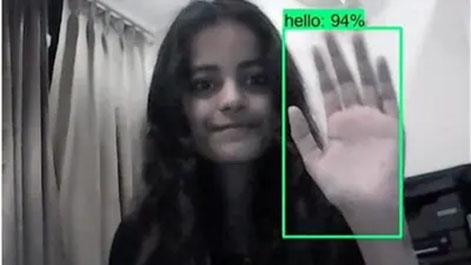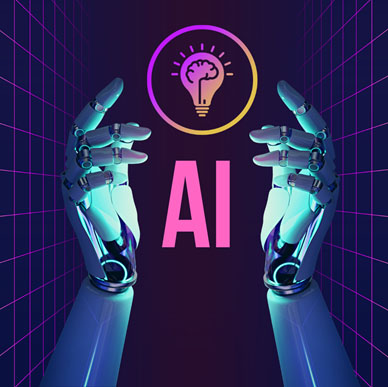Introduction
Artificial Intelligence (AI) has revolutionized translation technology, helping to bridge language gaps and improve communication worldwide. Companies like Google and Facebook are at the forefront, using AI to enhance their translation services. Adding to these innovations, a talented third-year engineering student from India has developed an impressive AI model that can detect American Sign Language (ASL) and translate it into English in real-time.

This breakthrough model interprets ASL gestures, providing instant English translations, thus facilitating smoother communication between ASL users and English speakers. This AI model stands out as a game-changer, offering significant potential for enhancing accessibility and inclusivity for the deaf and hard-of-hearing communities, making interactions more seamless and effective.
The ASL model that broke the internet
Priyanjali Gupta, a student at Vellore Institute of Technology (VIT), recently shared an impressive video on her LinkedIn profile, showcasing her innovative AI-based ASL (American Sign Language) Detector. This AI model can detect and translate basic sign language gestures into English in real-time. However, at the moment, it only supports a few words and phrases, such as “Hello,” “Please,” “Thanks,” “I Love You,” “Yes,” and “No.”

Gupta built this model using the Tensorflow object detection API, which is a tool that helps computers recognize and identify objects in images and videos. To make her ASL Detector, she used a technique called transfer learning with a pre-trained model called ssd_mobilenet. Transfer learning allows developers to take an existing model that has already learned to recognize certain objects and modify it to recognize new objects—in this case, ASL signs.
It’s important to note that Gupta’s AI model doesn’t actually translate ASL directly into English. Instead, it works by identifying the hand signs as objects. For example, when someone signs “Hello,” the AI recognizes the shape and movement of the hand and matches it with the pre-programmed “Hello” gesture in its database.
This project is a great step forward in making communication easier for people who use sign language. Although it’s still in the early stages, with more words and phrases to be added, Gupta’s work shows the potential of AI in bridging language barriers and enhancing communication. Her use of existing technology in new ways is both creative and inspiring.
The final question: Is AI a boon or curse?
AI, or artificial intelligence, is often seen as both a boon and a curse, depending on how it is used.
On the positive side, AI can make our lives easier and more efficient. For example, virtual assistants like Siri and Alexa can answer our questions, set reminders, and even control smart home devices. In healthcare, AI can help doctors diagnose diseases more accurately and quickly by analyzing medical data. Self-driving cars, powered by AI, promise to reduce traffic accidents and make transportation more accessible.
However, AI also has its drawbacks. One major concern is job loss. As AI systems become more capable, they can replace human workers in various fields, leading to unemployment. For instance, automated machines can perform tasks on factory floors that were once done by humans. Additionally, AI can be misused, such as in creating deepfakes or other deceptive content that can spread misinformation and harm reputations.
How does AI help in marketing?
AI helps in marketing by making tasks faster, easier, and more effective. One key area is personalized advertising. For example, AI can analyze a customer’s browsing history and recommend products they are likely to buy. This means you see ads for things you’re actually interested in, rather than random products.
Another great use of AI in marketing is chatbots. These are automated systems that can answer customer questions 24/7. For instance, if you’re shopping online at midnight and have a question, a chatbot can provide instant help, making your shopping experience smoother.

AI also helps in content creation. Tools like AI writing assistants can generate blog posts, social media updates, and even email campaigns. This speeds up the process and ensures the content is relevant and engaging. For example, a company might use AI to generate weekly newsletters tailored to each subscriber’s interests.
Additionally, AI can analyze massive amounts of data to identify trends and patterns. This helps marketers understand what strategies are working and what needs improvement. For example, AI can analyze social media interactions to determine which posts are most popular and why, helping companies create more effective content in the future.
How to Design an AI Marketing Strategy?
Designing an AI marketing strategy involves using artificial intelligence to enhance your marketing efforts and make them more efficient. Start by identifying your marketing goals, such as increasing sales, improving customer engagement, or expanding your audience. Then, gather data from various sources like social media, website analytics, and customer feedback.
Next, use AI tools to analyze this data. For instance, AI can help segment your audience based on behavior and preferences, allowing you to create personalized marketing campaigns. An example is using an AI tool to analyze customer purchase patterns and recommend products they are likely to buy. This targeted approach increases the chances of conversion and customer satisfaction.
AI can also automate repetitive tasks like sending emails, managing social media posts, and even creating content. For example, an AI-powered email marketing tool can automatically send personalized emails to your customers at the best times, improving open and click-through rates.
Finally, continuously monitor and adjust your strategy based on AI insights. This helps you stay responsive to changing customer behaviors and market trends, ensuring your marketing efforts are always optimized for the best results.
Free AI Tools for Marketing
There are several free AI tools available that can enhance your marketing efforts. For instance, HubSpot’s free CRM offers AI-powered insights into customer interactions, helping you manage relationships more effectively. Canva uses AI to help create stunning visuals for social media, even if you’re not a designer.
Free AI Tools for Advertising
For advertising, free AI tools like Google Ads provides automated bidding and targeting options, optimizing your ad spend for better results. Facebook Ads Manager uses AI to analyze ad performance and suggest improvements, making it easier to reach your target audience effectively. These tools help small businesses compete with larger ones by making sophisticated advertising techniques accessible without the high costs.
Conclusion
In conclusion, AI has a transformative impact on marketing, making it more efficient and targeted. By leveraging AI for personalized advertising, companies can better cater to individual preferences, enhancing customer satisfaction. The use of chatbots and AI-driven content creation tools streamlines operations and ensures timely, relevant communication with customers. Furthermore, AI’s ability to analyze vast amounts of data helps businesses refine their strategies and stay competitive. Overall, AI’s integration into marketing not only improves user experience but also drives better business outcomes, demonstrating its significant potential in the digital age.